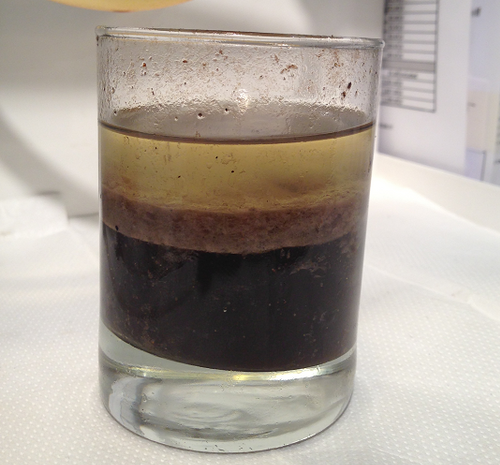ITS REAL- Fuel Contamination
2 February 2022
Did you know the biggest cause of breakdowns on water is fuel related issues? Yes, have you heard of the dreaded Diesel bug? If you are reading this then I advise you to pop the kettle on, take a break and read on.

Lets talk about FUELCONTAMINATION!
Did you know the biggest cause of breakdowns on water is fuel related issues?
Yes, have you heard of the dreaded Diesel bug? If you are reading this then I advise you to pop the kettle on, take a break and read on.
Diesel bug is the collective name for the microbial infestation that causes sludge and slime build up in your tanks that blocks your fuel filters. It’s made up of the bacteria, yeasts and moulds which the fuel absorbs from the air. The bugs attach themselves to the water droplets in your fuel and drop to the bottom of the tank where they feed from the fuel above. They double in numbers every 20minutes, excrete waste and die, leaving the sludge and slime that clogs your filters.
It's more than Just Diesel-Bug
In the past engines could easily handle a certain amount of water in fuel without any obvious running problems (excluding diesel bug contamination) but it will cause damage to the engine, especially today’s high powered engines with common rail fuel injectors. These engines have fine tolerances and rely on fuel as a lubricant, the water molecules reduce the amount of lubrication given by the fuel causing additional wear. As well as injectors it can damage pumps and cause corrosion. Critically there is the possibility of explosive damage to the fuel injectors as the combustion process super-heats any water present.
Where Does the Water Come From?
Water comes from the supplier, insecure tank fittings and the atmosphere in the form of condensation. Let's look at these three ingress points.
The Supplier? Fuel changes hands, and tanks, as much as 7 times before you, the end user, receives it. After refining it is stored, transported and transferred each time the fuel is traded. Be that in tanks on ships, barges or road tankers to finally being received into your tank at each point the fuel picks up contaminates in the form of debris and the biggest contaminant; water. The debris can easily be filtered out but the water is more difficult to remove so can often end up in your tank.
Insecure Tanks Fittings? Although self explanatory we hear a lot of stories of water in tanks that after investigation has come from loose filler caps, perished or missing gaskets, broken tank breather pipes, sounding pipes etc etc. Even overenthusiastic deck washing….yes really
Condensation? As the tank heats during the day and cools at night the fuel expands and contracts expelling air and drawing it back into the tank, This moisture laden air readily condenses on the tank wall and falls to the bottom as free water. It is insidious, a very small amount every single day, worse on some days better on others but non the less it very very slowly builds up on the bottom of the tank. this is made worse If the fuel contains Bio-Diesel (FAME). Bio Diesel is 30 times more hygroscopic than standard diesel meaning it readily absorbs water from the atmosphere. depending on which country you are in, condensation is by far the biggest source of water.
What is so harmful about the water?
Water in the bottom of a diesel tank is by far the single greatest contaminant you will find and will quickly lead to many problems. Water accelerates the degradation of diesel, it forms a habitat for Diesel Bug, it reduces the lubricity in the fuel, it helps the agglomeration of asphaltenes. Rusts the tanks and fuel system and in extreme cases when absorbed in the fuel can turn to super heated steam and blow the top of the fuel injectors in even worse cases, where areas of the tank is stagnant and no oxygen is available a highly aggressive special bug (anaerobic bacteria) grows that allows sulphuric acids to form. This creates resins in the fuel adding to the sludge and can eat through 1/2 inch steel plate . The resins look like sand, can be almost as hard and can pass through filters wrecking fuel pumps.
Free and Emulsified Water
Modern diesel particularly in the form of biodiesel readily absorbs moisture from the air. Free water gives rise to microbes and emulsified diesel can cause an even greater problem, not only does this widen the platform for diesel bug but is taken through the injection process where this can become super heated and cause catastrophic failure of the tip of the injector leading to turbocharger failure etc., Furthermore free and emulsified water in diesel removes what little lubrication the fuel has and gives rise to corrosion when the engine is stopped. Free water is easily removed by simply opening the drain valve regularly. If you don't have a drain then a Marine 16 Diesel Dipper sucking up through a top mounted dip tube will enable water and sludge to be removed from the bottom of the tank.
Prevention is Better than Cure
The best way to ensure your diesel stays free from diesel bug is to remove the habitat diesel bugs thrives in– the water. Water is present in all fuel and by removing water from your diesel you remove their home and breeding ground. Without water, diesel bug has nowhere to live.
The Cure
Depending on how bad the diesel bug infestation is, it may be that a simple shot of broad spectrum biocide will do the job. But be aware that it is important to remove the water, this cannot be stressed enough. Don’t be tempted to use an additive that absorbs water into the fuel. This water will go through the the engine resulting in the problems outlined above.
Our advise is remove the water mechanically by draining or with a Diesel Dipper and dose with a MARINE16 biocide. (Diesel Bug Treatment)
Marine 16 Diesel Bug Treatment (BUY ONLINE)
Diesel Bug Treatment is abroad spectrum biocide formulated to prevent or eradicate the microbial contamination of fuel from Yeast, Mould and Bacteria commonly known as Diesel Bug. A 100ml bottle is sufficient to prevent diesel bug growth in 2000 litres of fuel (50ppm). For serious contamination this should be increased to 100ml to100 litres (1000ppm). Our diesel bug treatment disperses into both the water and fuel phases in your tank and will remain sufficiently active for over a year at both high and low temperatures. Marine 16’s Diesel Bug Treatment is the fuel treatment of choice for the RNLI, The Royal Marines, Sea Start and River Canal Rescue as well as being number 1 in the Practical Boat Owner magazine review.
Overdosing will not harm your engine.
Marine 16s Diesel Dipper(BUY ONLINE)
The Diesel Dipper® sucks from the VERY BOTTOM of the tank. It will remove Diesel Bug, sludge, water and contaminants that are sloshing about on the very bottom, below the fuel suction. Sucked up with a 12v pump into the Dipper they are then removed by simply draining off. The clean fuel is returned back to the tank through a fine washable stainless steel filter.
The Dipper is a "By Pass system", independent of the engine it transfers the contents from the bottom of your large diesel tank into a small tank where they are removed. The "Tank Separator" forms the heart of the system. Entering the top, water and sludge collects in a chamber and is easily drained off.
The Diesel Dipper is connected to the drain plug. If a drain plug is not fitted we can supply a "Dip Tube". This simple fitting, attached to the top of the tank, allows a 10 mm draw pipe to be pushed through to rest on the bottom. The Diesel Dipper is then connected to the top of this pipe.
Have any questions?
Call the Marine 16 team on 01686 622213 or email info@marine16.co.uk
www.marine16.co.uk
Latest
PowerBoat & Rib
2 February 2022
Battle of the Diesel Bug Choose Your Weapons!
2 February 2022
ITS REAL- Fuel Contamination
2 February 2022
-p-500.jpeg)
